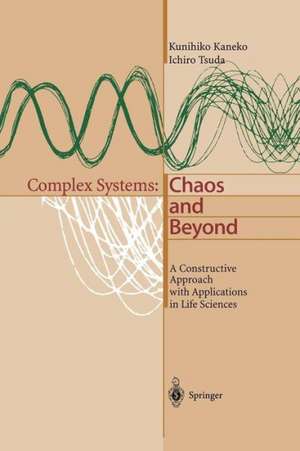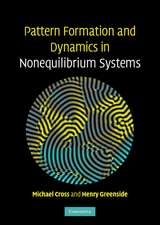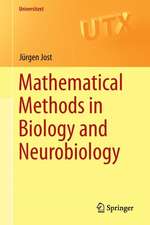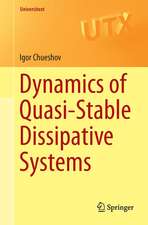Complex Systems: Chaos and Beyond: A Constructive Approach with Applications in Life Sciences
Autor Kunihiko Kaneko, Ichiro Tsudaen Limba Engleză Paperback – 21 oct 2012
| Toate formatele și edițiile | Preț | Express |
|---|---|---|
| Paperback (1) | 640.24 lei 6-8 săpt. | |
| Springer Berlin, Heidelberg – 21 oct 2012 | 640.24 lei 6-8 săpt. | |
| Hardback (1) | 646.43 lei 6-8 săpt. | |
| Springer Berlin, Heidelberg – 4 oct 2000 | 646.43 lei 6-8 săpt. |
Preț: 640.24 lei
Preț vechi: 753.22 lei
-15% Nou
Puncte Express: 960
Preț estimativ în valută:
122.51€ • 131.01$ • 102.15£
122.51€ • 131.01$ • 102.15£
Carte tipărită la comandă
Livrare economică 18 aprilie-02 mai
Preluare comenzi: 021 569.72.76
Specificații
ISBN-13: 9783642631320
ISBN-10: 3642631320
Pagini: 292
Ilustrații: XIII, 274 p.
Dimensiuni: 155 x 235 x 15 mm
Greutate: 0.41 kg
Ediția:Softcover reprint of the original 1st ed. 2001
Editura: Springer Berlin, Heidelberg
Colecția Springer
Locul publicării:Berlin, Heidelberg, Germany
ISBN-10: 3642631320
Pagini: 292
Ilustrații: XIII, 274 p.
Dimensiuni: 155 x 235 x 15 mm
Greutate: 0.41 kg
Ediția:Softcover reprint of the original 1st ed. 2001
Editura: Springer Berlin, Heidelberg
Colecția Springer
Locul publicării:Berlin, Heidelberg, Germany
Public țintă
ResearchCuprins
1. Necessity for a Science of Complex Systems.- 1.1 Introduction.- 1.2 Chaos.- 1.3 Chaos and Complexity.- 1.4 How Has Chaos Changed Our Way of Thinking?.- 1.5 Dynamic Many-to-Many Relations and Bio-networks.- 1.6 The Construction of an Artificial (Virtual) World.- 1.7 A Trigger to Emergence.- 1.8 Beyond Top-Down Versus Bottom-Up.- 1.9 Methodology of Study of Complex Systems.- 2. Observation Problems from an Information-Theoretical Viewpoint.- 2.1 Observation Problems of Chaos.- 2.2 Undecidability and Entire Description.- 2.3 A Demon in Chaos.- 2.4 Chaos in the BZ Reaction.- 2.5 Noise-Induced Order.- 2.6 Could Structural Stability Lead to an Adequate Notion of a Model?.- 2.7 Information Theory of Chaos.- 3. CMLs: Constructive Approach to Spatiotemporal Chaos.- 3.1 From a Descriptive to a Constructive Approach of Nature.- 3.2 Coupled Map Lattice Approach to Spatiotemporal Chaos.- 3.3 Phenomenology of Spatiotemporal Chaos in the Diffusively Coupled Logistic Lattice.- 3.4 CML Phenomenology as a Problem of Complex Systems.- 3.5 Phenomenology in Open-Flow Lattices.- 3.6 Universality.- 3.7 Theory for Spatiotemporal Chaos.- 3.8 Applications of Coupled Map Lattices.- 4. Networks of Chaotic Elements.- 4.1 GCM Model.- 4.2 Clustering.- 4.3 Phase Transitions Between Clustering States.- 4.4 Ordered Phase and Cluster Bifurcation.- 4.5 Hierarchical Clustering and Chaotic Itinerancy.- 4.6 Marginal Stability and Information Cascade.- 4.7 Collective Dynamics.- 4.8 Universality and Nonuniversality.- 5. Signifieanee of Coupled Chaotic Systems to Biological Networks.- 5.1 Relevance of Coupled Maps to Biological Information Processing.- 5.2 Application of Coupled Maps to Information Processing.- 5.3 Information Dynamics of a CML with One-Way Coupling.- 5.4 Design of Coupled Maps and Plastic Dynamics.- 5.5 Construction of Dynamic Many-to-Many Logic and Information Processing.- 5.6 Implications to Biological Networks.- 6. Chaotic Information Processing in the Brain.- 6.1 Hermeneutics of the Brain.- 6.2 A Brief Comment on Hermeneutics (the Inside and the Outside).- 6.3 A Method for Understanding th e Brain and Mind - Internal Description.- 6.4 Evidence of Chaos in Nervous Systems.- 6.5 The Origin of Neurochaos.- 6.6 The Implications of Stochastic Renewal of Maps.- 6.7 A Model for Dynamic Memory.- 6.8 A Model for Dynamically Linking Memories.- 6.9 Significance of Neurochaos.- 6.10 Temporal Coding.- 6.11 Capillary Chaos as a Complex Dynamics.- 7. Conversations with Authors.- 7.1 Concluding Discussions.- 7.2 Questions and Answers.- References.
Recenzii
From the reviews:
SIAM REVIEW
"To sum up, the book should be a must-read for those interested in the modeling of coupled nonlinear systems…the interest of the global view of complexity that it provides makes it a highly recommendable read."
SIAM REVIEW
"To sum up, the book should be a must-read for those interested in the modeling of coupled nonlinear systems…the interest of the global view of complexity that it provides makes it a highly recommendable read."
Textul de pe ultima copertă
Chaos in science has always been a fascinating realm since it challenges the usual scientific approach of reductionism. While carefully distinguishing between complexity, holism, randomness, incompleteness, nondeterminism and stochastic behaviour the authors show that, although many aspects of chaos have been phenomenologically understood, most of its defining principles are still difficult to grasp and formulate. Demonstrating that chaos escapes all traditional methods of description, the authors set out to find new methods to deal with this phenomenon and illustrate their constructive approach with many examples from physics, biology and information technology. While maintaining a high level of rigour, an overly complicated mathematical apparatus is avoided in order to make this book accessible, beyond the specialist level, to a wider interdisciplinary readership.
Caracteristici
Both authors have an outstanding academic record as far as their research in the field of chaos theory is concerned This book, the first among a planned series of many on this subject, is the outcome of many years of efforts to give an new all-encompassing approach to complex systems in nature based on chaos theory Includes supplementary material: sn.pub/extras











